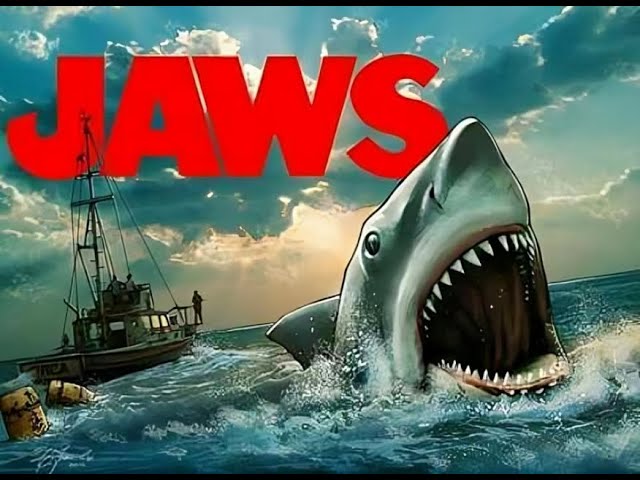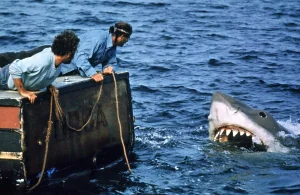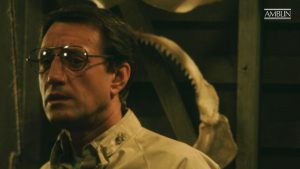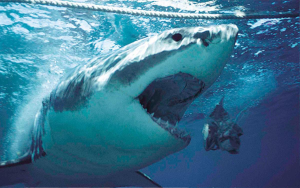“Jaw 1975”

“Jaws” (1975) is a groundbreaking thriller directed by Steven Spielberg and based on the novel by Peter Benchley. It is widely regarded as one of the greatest films of all time, setting the standard for summer blockbusters and revolutionizing the thriller genre. The film’s suspenseful storytelling, iconic score, and masterful use of tension helped make it a cultural phenomenon and turned Spielberg into a household name.
Plot Summary
Jaws is set in the fictional beach town of Amity Island, where the community is gearing up for a busy summer season. The peaceful atmosphere is shattered when a young woman is attacked and killed by a large, unseen creature while swimming in the ocean. Chief Martin Brody (Roy Scheider), the town’s newly appointed police chief, is tasked with investigating the attack. While the evidence points to a shark, Brody is faced with resistance from the town’s mayor, Larry Vaughn (Murray Hamilton), and business owners who are more concerned about the upcoming tourist season than closing the beaches.
When a second victim is killed, Brody teams up with Matt Hooper (Richard Dreyfuss), a marine biologist, and Quint (Robert Shaw), a grizzled professional shark hunter, to hunt down the dangerous predator. The trio sets out on the open ocean aboard Quint’s boat, the Orca, determined to capture or kill the shark before it claims more lives. As the shark terrorizes the island, the group faces increasingly perilous situations, and Brody must confront both his fear of the ocean and his responsibility as the town’s protector.
The film builds toward a suspenseful and terrifying final showdown between the men and the shark, with Brody ultimately confronting the beast in an epic battle for survival.
Key Themes
- Fear of the Unknown: One of the central themes of Jaws is the fear of the unknown, amplified by the unseen nature of the shark in the early parts of the film. Spielberg’s decision to keep the shark largely out of sight for much of the movie heightens the tension, as audiences are forced to imagine the creature lurking just beneath the surface. This fear of the unseen predator taps into primal anxieties about the dangers that lie beneath the surface, both literally and metaphorically.
- Man vs. Nature: The struggle between humanity and the natural world is a significant theme in Jaws. The film explores how human beings, in their desire to control and conquer nature, are often helpless in the face of a force that cannot be reasoned with. The shark represents an unpredictable force of nature that cannot be easily defeated, highlighting humanity’s vulnerability when confronted with nature’s raw power.
- Heroism and Duty: Chief Brody’s arc is centered on his sense of duty as a protector of the town. While initially hesitant and fearful of the ocean, Brody steps up to the challenge when he realizes that it is his responsibility to protect the people of Amity Island. His character evolves from a fearful outsider to a determined hero willing to sacrifice everything for the safety of his community.
- Courage and Fear: The film examines the tension between courage and fear, particularly through the characters of Brody, Hooper, and Quint. Each character deals with their fear of the shark in different ways—Brody is terrified of the ocean but learns to face his fear, Hooper is scientifically curious but also unnerved by the shark’s power, and Quint is obsessed with hunting the shark, driven by both his courage and his personal vendetta.
- The Dangers of Complacency: The film also critiques the complacency and greed of the town’s leadership. Mayor Vaughn’s reluctance to close the beaches and his refusal to acknowledge the danger posed by the shark until it’s too late reflects the human tendency to ignore danger in the face of financial gain and the desire to maintain the status quo.

Character Development and Performances
- Chief Martin Brody (Roy Scheider): Roy Scheider’s portrayal of Brody is one of the film’s highlights. Brody is a complex character, a man who is terrified of the ocean but has a deep sense of duty to protect his town. Scheider captures the internal conflict between Brody’s fear and his courage, making him a relatable and sympathetic protagonist. Brody’s evolution from a nervous outsider to a decisive hero is a key aspect of the film’s emotional depth.
- Matt Hooper (Richard Dreyfuss): Richard Dreyfuss plays Matt Hooper, a marine biologist who is eager to understand the shark and uses his scientific knowledge to help Brody. Hooper is a contrast to Brody in many ways—confident, knowledgeable, and calm in the face of danger—but Dreyfuss brings a charm and humor to the character that makes him an engaging presence. Hooper’s interactions with Brody provide both comic relief and moments of camaraderie, deepening the friendship between the two characters.
- Quint (Robert Shaw): Robert Shaw’s performance as Quint, the tough and obsessive shark hunter, is one of the most memorable in the film. Quint is a character driven by his past experiences, particularly his time aboard the USS Indianapolis during World War II, where he witnessed horrific events. Shaw brings a sense of gravitas to the role, and Quint’s emotional breakdown in the film’s final act adds unexpected depth to his character. His obsession with killing the shark ultimately leads to his tragic end.
- The Shark: While not a human character, the shark itself is an essential part of Jaws and is portrayed as an almost mythical force of nature. The shark’s presence is often felt through its ominous theme music (composed by John Williams) rather than through its actual on-screen appearance, making it one of cinema’s most iconic antagonists. The mechanical shark, known as Bruce, became a challenge during production, but its limited use in the film turned out to be a blessing, as it allowed Spielberg to focus on building suspense and tension through sound and atmosphere rather than showing the shark too early.

Cinematography and Direction
One of the key elements that makes Jaws so effective is Spielberg’s direction and the way he builds suspense. Spielberg masterfully manipulates the pacing, using long stretches of silence and slow reveals to keep the audience on edge. The use of POV shots from the shark’s perspective, combined with the iconic John Williams score, creates a feeling of impending doom that is palpable throughout the film.
The cinematography by Bill Butler is also crucial to the film’s success. The shots of the ocean, the beach, and the island setting all convey a sense of isolation and vulnerability, while the underwater shots heighten the sense of danger that lies beneath the surface. Spielberg’s decision to keep the shark largely hidden until the final act made the moments when it does appear all the more terrifying.
Music and Soundtrack
The film’s score, composed by John Williams, is iconic and instantly recognizable. The “duh-duh, duh-duh” motif for the shark became one of the most famous musical cues in film history, creating an unmistakable association between the sound and the shark’s imminent attack. Williams’ score builds tension perfectly, with his use of music often heightening the anticipation of the shark’s appearance. The soundtrack’s ability to evoke fear and anxiety while also underscoring moments of heroism and emotion is one of the film’s standout features.
Reception and Legacy
Upon its release, Jaws became a cultural phenomenon. It was not only a commercial success but also received widespread critical acclaim for its thrilling suspense, strong performances, and innovative filmmaking. The film grossed over $470 million worldwide, making it the highest-grossing film of all time until “Star Wars” (1977) surpassed it.
Jaws is often credited with inventing the concept of the summer blockbuster, as its wide release in the summer of 1975 set the stage for a new era of big-budget, high-stakes films designed to dominate the box office. The film also had a major impact on the horror and thriller genres, influencing filmmakers and becoming a template for suspenseful storytelling.
Jaws won three Academy Awards, including Best Original Score for John Williams, and was nominated for Best Picture, Best Director, and Best Film Editing. It has since been included in numerous “best films of all time” lists and remains a pivotal moment in film history.
Fun Facts
- Mechanical Shark: The shark used in the film was nicknamed “Bruce” after Steven Spielberg’s lawyer. The mechanical shark frequently malfunctioned during filming, which led Spielberg to reduce its on-screen presence. This limitation ended up enhancing the film’s suspense, as the shark was kept mostly hidden.
- Real Sharks: Some of the underwater shots in the film were filmed with real sharks, which added to the sense of danger during the action sequences.
- Iconic Line: The famous line, “We’re gonna need a bigger boat,” was improvised by Roy Scheider during filming. It was kept in the final cut and became one of the most memorable quotes in film history.
Conclusion
Jaws (1975) is a masterpiece of suspense and storytelling, blending horror, action, and psychological tension with strong performances and a masterful direction by Steven Spielberg. The film’s lasting impact on popular culture, its groundbreaking use of sound and visual effects, and its ability to evoke primal fear make it one of the most influential films ever made. With its iconic score, unforgettable characters, and thrilling narrative, Jaws remains a classic that continues to entertain and terrify audiences around the world.










